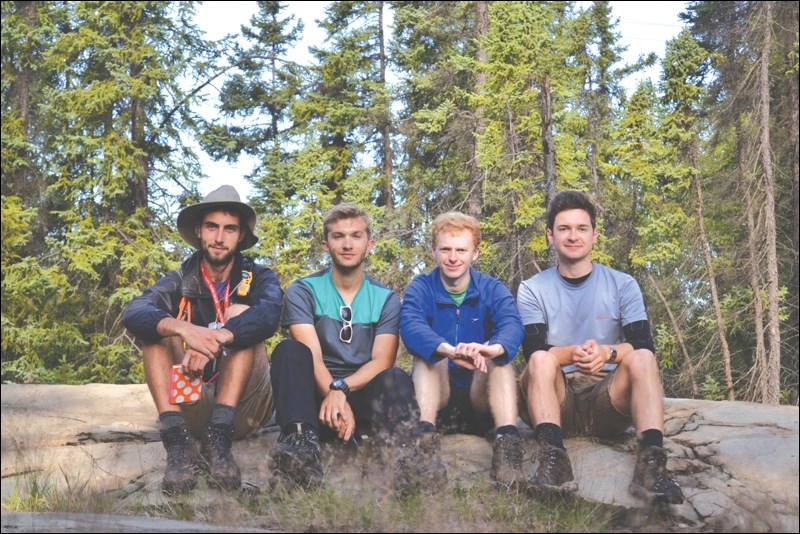Four geology students from the UK are spending five weeks touring Flin Flon’s rock face to develop new maps and collect data.
Matt Lees, Dan Spencer, Julian Steward and Alex Clark have already been in the community for nearly three weeks for their project.
The men are among about 50 UK students touring the world to complete geological studies for their third year at the renowned University of Cambridge.
“You get to choose anywhere in the world,” said Lees.
The men came to Canada because of available funding as well as the unique opportunity it presented.
“We started looking around at which Canadian geological places might be good to go to and we came across the contact of [retired Flin Flon geologist] Dave Price,” said Lees. “He was very helpful and accommodating, and it evolved from there.”
They’ve since discovered Flin Flon’s unique sense of community, but the biggest attraction for the foursome was the ore-rich Flin Flon Greenstone Belt.
“There are only two or three places in the world with greenstone belts – South Africa, Australia [and here],” said Spencer. “The geology is fantastic here. You’ve got really good exposure here which is fantastic. And everyone has been super friendly.”
The students will spend the next two weeks continuing to map an area about eight or 10 square kilometres – located around Little Cliff Lake – and collect data for their final report and geological map.
“It’s hard to know what to expect,” said Clark. “We sort of looked at the area and have to check a map that someone else had produced about 50 years ago that just gives us a rough idea of what to expect and where to base ourselves.
“But until you’ve been on the ground, you don’t know whether you can indentify the units, where there are trees and where there weren’t trees [when the map was made], and where the exposure is now.”
The biggest surprise the group has come across so far was during lunch the other day.
“We had a close encounter with a bear,” said Steward. “We were just eating lunch and I looked up and there was a bear. Once I processed it, it was like, ‘Oh s**t, there’s a bear.’”
Steward says the bear took off after the group shouted at it.
“He was quite keen on our jam sandwiches,” said Lees. “So that was fun. You don’t get that in the UK.”
Along with types of rocks and data to expect, the group says they were warned about bears and even given bear spray, which Lees says offers “peace of mind.”
The group is at the halfway point of their project and are pleased with the progress they have made.
“At some point we’ll finish our area in terms of being everywhere, and then we’ll have to go and fill in the gaps,” said Clark. “We’ll find more data where we need to fill gaps, get more information for our projects and get evidence to support the ideas.”
Along with collecting data, the students draw sketches of the rocks they find as well as take pictures and include details on the map of where it was found.
As for how much distance they cover in a typical day, Spencer says it all depends on the area.
“It depends on how many trees there are,” Spencer said. “If it’s pretty bare then maybe we’ll cover half a square kilometre, but if there are more trees then we can get up to about three quarters of a square kilometre.”
“It just all depends on what’s going on and how interesting it is,” said Clark. “The more interesting it is, the less [distance] we go.”
Clark says some areas will feature the same rock unit for quite a distance, whereas other areas will have three or four different rocks together.
“It varies widely,” he said.
Even though they put in about eight hours a day, six days a week, the students have had a chance to explore more than just rocks.
They are staying with local residents Chad and Kara Plamondon and have been able to visit their cabin as well as get out on the water.
As for similarities of home, Lees says there is one big one.
“The Queen is always staring at us on the $20 note. We can’t get away,” he laughed.
“But I think it’s just the small things like walking around the supermarket and seeing brand products that you’re used to,” said Spencer.
The friends came prepared with favourite things from home – but maybe a little too prepared as Lees brought a big stash of dark chocolate and Steward brought jam from Scotland.
“We did just happen to have the jam. I think we were aware we’d be able to get jam here,” Spencer laughed.
A big difference has been the “strange yellow object in the sky” as the students have experienced quite a bit of sun while in Flin Flon, rather than the rain back home.
After finishing their work in the Flin Flon area, the students hope to spend a few days touring the Rocky Mountains.
They will return to the University of Cambridge for their third year of study this fall with the option to advance to fourth year for their Master’s degrees.




